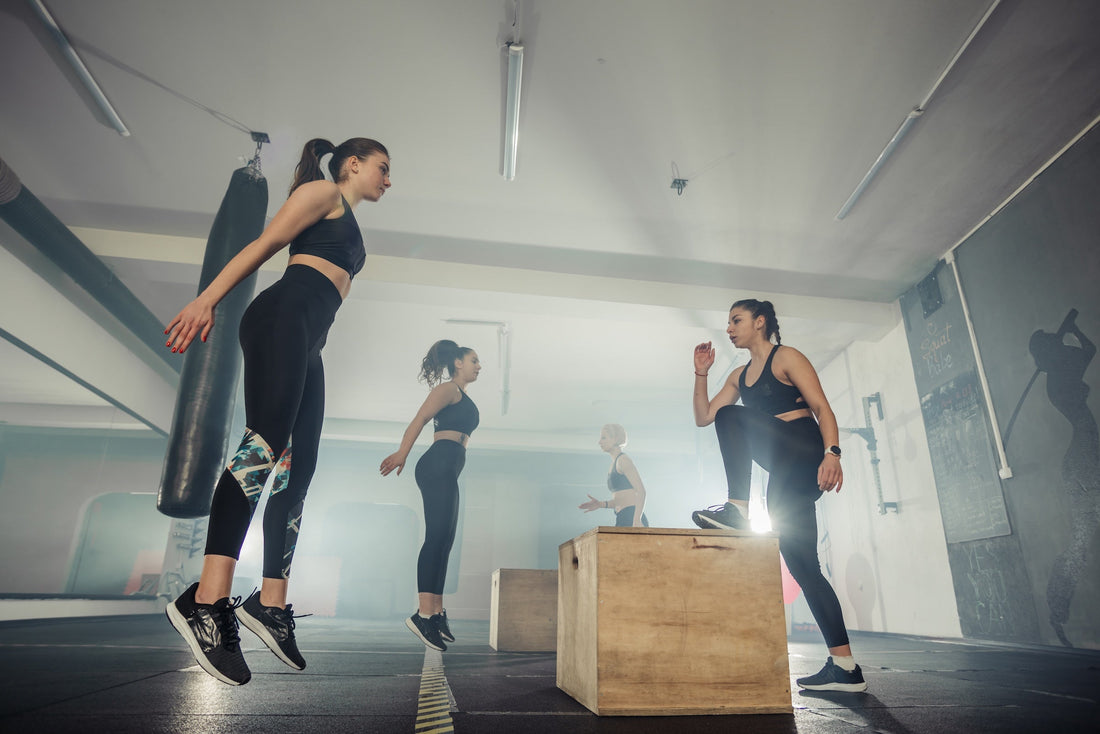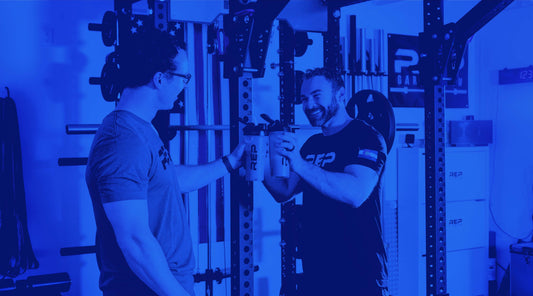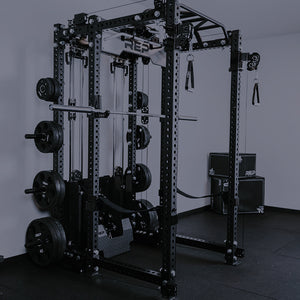
Jump up, jump up, and get down.
If you’ve ever taken a HIIT class — in the park, at your local gym, or in your living room to P90X DVDs from 500 years ago — you’ve probably done jump squats or squat jumps. The move seems simple, right? Squat down, jump up, repeat. But chances are, you’re not doing them in a way that actually gets results.
For the unacquainted, this move is a powerhouse for building explosive leg strength and boosting cardiovascular health. In this guide, we’ll break down how to fix your form and milk every last morsel of power and strength from each rep.
How to Do Jump Squats The Right Way
Whether you’ve done them before, are new to the game, or you’re looking for alternatives to barbell back squats, here’s a step-by-step guide on how to perfect the jump squat exercise.
-
Start standing tall with feet facing forward and shoulder width apart.
-
Bend your knees and send your hips back, sitting down into an imaginary chair behind you until you’ve dropped into a full squat position. Swing your arms back in preparation of using them to help create power as you jump.
-
Now, as you drive up out of that squat, push through your heels as you lift up onto your toes.
-
Swing your arms forward to help propel you into a jump, extending your hips and knees as you press off the floor with explosive power. Aim to leap as high as you can go.
-
Land softly with bent knees and quickly drop back down into your squat, shifting your weight back onto your heels in one motion as your arms swing behind again.
Common Jump Squat Mistakes
Maybe you’ve had to Google “what are jump squats” — it’s fine, I Googled, “how to get spiders to stop living in car” the other day (we're all learning something new). Or maybe you’ve been doing them for decades. Either way, here are some common mistakes that both novice and experienced athletes will want to avoid.
Less speed, more height: One of the most common mistakes made when doing a jump squat workout is rushing through the reps. While this quick movement gets your heart rate up — and there’s a time and a place for that — you’ll miss out on building real lower-body power. Instead, focus on quality over quantity: each jump should be explosive, with the goal of getting as high off the ground as possible.
Knee valgus: Just like when you’re banging out reps of a back squat or goblet squat, it’s important for joint health to keep your knees from caving in — aka, knee valgus. Maintain body awareness as you complete your reps, with effort placed on keeping your knees gently pressed outward as you squat and jump.
Locked out knees: When you land after an explosive jump, your body has built up momentum — meaning you’re absorbing a force greater than your body weight. If your knees are locked out, that force goes straight to your joints. To protect your knees from strain, jumping squats should be performed with a soft bend in the knee. This helps absorb shock, limit the risk of hyperextension, and aids in keeping you balanced.
Jump Squat Muscles Worked and Benefits
- glutes
- quads
- hamstrings
- calves
Jump squats benefit athletes by building explosive power and improving vertical jump height. “They also strengthen key lower-body muscles — glutes, quads, hamstrings, and calves," says Steven Ijams, former D1 setter/opposite, AVP player, and founder and head coach of South Bay Volleyball. "This leads to quicker, more powerful movements on the court, field — wherever you play."
While this type of plyometric training is the bread and butter for athletes who rely on explosive power — think track and field, volleyball, basketball, football, tennis, and soccer — jump squats are also a powerful training tool for anyone looking to improve cardiovascular health, burn calories, and build lower-body strength without equipment.
“Jump squats also enhance neuromuscular coordination, helping athletes react faster and move more efficiently during play,” adds Ijams. “Additionally, they improve balance and core stability, which are crucial for maintaining control during dynamic actions like changing direction, landing, and diving.”
Pretty impressive laundry list of benefits for a move that doesn't require a single piece of equipment.
How to Add Jump Squats to Your Workout
To help you add this explosive move to your routine, we spoke with NASM-CPT and CrossFit Level 1 coach Derrick Owens, who shared his go-to leg day routine — with jump squats as the finisher. And if you’ve ever seen the gams on Owens, or his insane 54.5-inch box jump, you’ll want to follow along.
Warm-Up
Get your body moving and your blood pumping, including banded lateral walks or forward-and-back walks. “Anything that helps to get the glutes warmed up for the work ahead,” says Owens.
Superset (Strength + Hypertrophy)
Now that your body is primed for movement, it’s time for the main event. “Choose a heavy squat or hip thrust to superset with an isolated leg exercise — think leg extensions or hamstring curls,” he explains.
Perform this superset by moving through these 2 movements, back-to-back, with minimal rest. Do 1-5 reps of the heavy squat or hip thrust to developing explosive strength, followed by 8-12 reps of the isolated leg exercise to target hypertrophy.
Aim for 3-5 sets.
Finisher (Power + Endurance)
“To finish it off, add jump squats to the end of your workout,” says Owens. “They’ll build up lactic acid in the muscles and help you improve muscular endurance and metabolic conditioning.”
For this finisher, use another superset: alternating between as many reps of jump squats you can perform in 20-30 seconds and a heavy lift — split squat, deadlift, whatever you fancy — with a slow eccentric focus. In the heavy lift, aim to lower for 3 seconds, then explode up on the concentric portion of the lift.
Owens adds that you can mix and match the specific lifts based on your goals, but this general structure — combining mechanical tension, slow eccentric movement, and metabolic stress — creates a well-rounded leg day that builds strength, explosiveness, and overall athleticism.
Aim for 2-3 sets.
Pro tip: To up the ante, try weighted jump squats by using a weighted vest or holding a dumbbell during the movement. Just be sure to master proper form and build a strong foundation before adding resistance.
Takeaway
While jump squats are excellent for athletes looking to get more air time, they’re also a versatile move that torches calories, builds power and strength, and improves endurance — no equipment needed. Lock in your form, press off the floor with some gusto, and when you’re ready, crank up the challenge by adding resistance or volume.
FAQ
What is a jump squat good for?
Jump squats help athletes build the kind of explosive power needed for sports, but they’re also a handy, no-equipment workout that most people can complete from the comfort of their own home.
Are jump squats harder than squats?
Yes. Jump squats are typically more difficult than squats because they add a plyometric element. While a jump squat starts with the basic squat pattern, it also engages more muscle groups and requires more energy to power you through the jump.

NEWSLETTER SIGNUP
Product launch information, promotions, blogs, and REP news.







